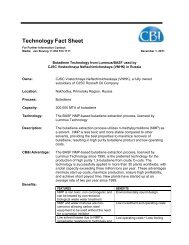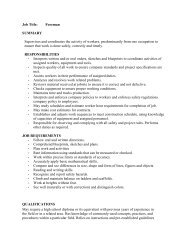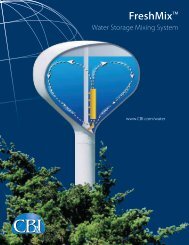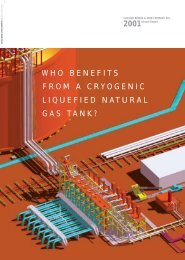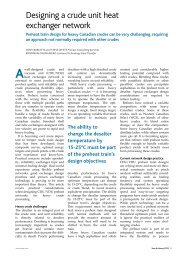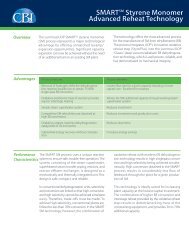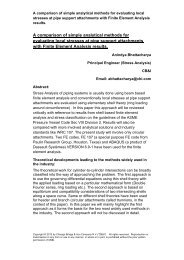DETOL®, LITOL®, and PYROTOL® Hydrodealkylation - CB&I
DETOL®, LITOL®, and PYROTOL® Hydrodealkylation - CB&I
DETOL®, LITOL®, and PYROTOL® Hydrodealkylation - CB&I
Create successful ePaper yourself
Turn your PDF publications into a flip-book with our unique Google optimized e-Paper software.
DETOL®, LITOL®, <strong>and</strong> PYROTOL®<br />
<strong>Hydrodealkylation</strong><br />
Overview<br />
The DETOL®, LITOL®, <strong>and</strong> PYROTOL® processes for<br />
hydrodealkylation are used to convert aromatic<br />
streams into high purity benzene. Lummus Technology<br />
has exclusive worldwide licensing rights to these<br />
processes, which are in service in over thirty plants<br />
throughout the world.<br />
These hydrodealkylation technologies can be<br />
designed for a client’s specific feedstock. Three<br />
possible sources of aromatic streams can be<br />
converted to high purity benzene, each requiring a<br />
different balance of hydrodealkylation, desulfurization,<br />
<strong>and</strong> hydrocracking reactions.<br />
DETOL process: converts alkyl aromatics in the C7 to<br />
C10 range. Also converts C9-C10 aromatic concentrates<br />
to C8 aromatics. Mainly requires hydrodealkylation.<br />
LITOL process: converts C6 to C9 by-products from the<br />
coking of coal. Mainly requires desulfurization <strong>and</strong><br />
smaller amounts of hydrodealkylation <strong>and</strong> hydrocracking<br />
of non-aromatics.<br />
PYROTOL process: converts C6 to C9 fraction of<br />
pyrolysis liquids obtained as a by-product of ethylene<br />
production. More hydrocracking of non-aromatics<br />
than the LITOL process, but a smaller amount of<br />
desulfurization, as well as a comparable amount of<br />
hydrodealkylation.<br />
Advantages<br />
Process Features<br />
High aromatic selectivity<br />
Single step process<br />
Lower operating temperature<br />
No coking in heat exchange system<br />
Highest product purity exceeding 99.93 wt%<br />
Process Benefits<br />
Higher product rate for a given feedstock<br />
Eliminates need for separate hydrotreating steps to reduce<br />
olefin or sulfur content in feedstock • Reduces cost<br />
Eliminates need for sulfur injections for metal passivation<br />
• Allows use of lower alloy metals<br />
Low maintenance costs • Eliminates aromatics saturated solid<br />
waste material<br />
High value product<br />
Performance<br />
Characteristics<br />
Feeds<br />
DETOL<br />
MT<br />
Toluene (98% Purity) 1,000<br />
Makeup Hydrogen (70% purity) 36<br />
LITOL<br />
Light Oil<br />
(96% BTX, 1.7% Styrene, 0.4% Sulfur) 1,000<br />
Makeup Hydrogen (90% purity) 53<br />
PYROTOL<br />
Pyrolysis Gasoline<br />
(73% BTX, 3.1% Styrene, 0.1% Sulfur) 1,000<br />
Makeup Hydrogen (90% purity) 69<br />
Products<br />
DETOL<br />
MT<br />
Benzene (99.95% purity) 835<br />
Fuel Gas 201<br />
LITOL<br />
Benzene (99.95% purity) 925<br />
Fuel Gas <strong>and</strong> Oil 128<br />
PYROTOL<br />
Benzene (99.95% purity) 695<br />
Fuel Gas <strong>and</strong> Oil 374
DETOL®, LITOL®, <strong>and</strong> PYROTOL® <strong>Hydrodealkylation</strong><br />
Process Flow<br />
Diagram<br />
Equipment within dashed area is not required by<br />
the DETOL <strong>and</strong> PYROTOL technologies to process<br />
partially hydrotreated feeds<br />
Recycle<br />
Gas Heater<br />
Pretreat<br />
Reactor<br />
Charge Heater<br />
Dealkylation<br />
Reactors<br />
Fresh Feed<br />
Vaporizer<br />
Steam Generator<br />
plus Process<br />
Heat Exchanger<br />
Fuel Gas<br />
Benzene<br />
Make Up<br />
Hydrogen<br />
Vapor/Liquid<br />
Separation<br />
<strong>and</strong><br />
Hydrogen<br />
Purification<br />
Unit<br />
Clay Treaters<br />
Benzene<br />
Tower<br />
Stabilizer<br />
Tower<br />
Toluene <strong>and</strong> heavier bottoms<br />
Process<br />
Description<br />
In LITOL <strong>and</strong> PYROTOL plants processing raw<br />
pyrolysis gasoline, the fresh feedstock is combined<br />
with recycled, unconverted aromatics <strong>and</strong> brought<br />
to system pressure. The total liquid feed is vaporized<br />
with preheated make-up hydrogen <strong>and</strong> hydrogenrich<br />
recycle gas. The vaporizer overhead is sent to a<br />
pretreat reactor where diolefins <strong>and</strong> olefins are<br />
partially hydrotreated, <strong>and</strong> a portion of thiophene<br />
<strong>and</strong> other sulfur compounds are converted to H2S.<br />
The pretreat reactor effluent is brought to dealkylation<br />
reactor temperature in a fired heater. Dealkylation<br />
reactor effluent heat is used to produce steam <strong>and</strong><br />
to heat other process streams.<br />
In DETOL <strong>and</strong> PYROTOL plants processing partially<br />
hydrotreated pyrolysis gasoline, the vaporizer,<br />
recycle gas heater <strong>and</strong> pretreat reactor are eliminated<br />
<strong>and</strong> the steam generator can be replaced by reactor<br />
feed effluent heat exchange.<br />
In all three processes, dealkylation is carried out<br />
catalytically. This permits the highest commercial<br />
conversion at the lowest temperatures, <strong>and</strong> also<br />
results in the highest selectivity <strong>and</strong> purity of<br />
recovered benzene. Catalytic dealkylation is<br />
performed at a temperature 38 to 52°C lower than<br />
the thermal route.<br />
Aromatics are recovered in a separation <strong>and</strong> purification<br />
unit <strong>and</strong> sent to the stabilizer tower.<br />
Reactor effluent vapor <strong>and</strong> liquid are also separated,<br />
<strong>and</strong> hydrogen is purified <strong>and</strong> combined with<br />
recycle gas.<br />
Impurities in the stabilized aromatics are removed<br />
by polymerization <strong>and</strong> absorption in clay treaters.<br />
The benzene tower produces high purity benzene,<br />
as well as a toluene <strong>and</strong> heavier bottoms product<br />
that is recycled as feedstock.<br />
www.CBI.com/lummus-technology<br />
Only employees, agents, or representatives authorized under <strong>and</strong> pursuant to written agreement<br />
with CB&I are authorized to distribute this brochure to an actual or potential client of CB&I.<br />
©Copyright 2012 by Chicago Bridge & Iron Company. All rights reserved.



